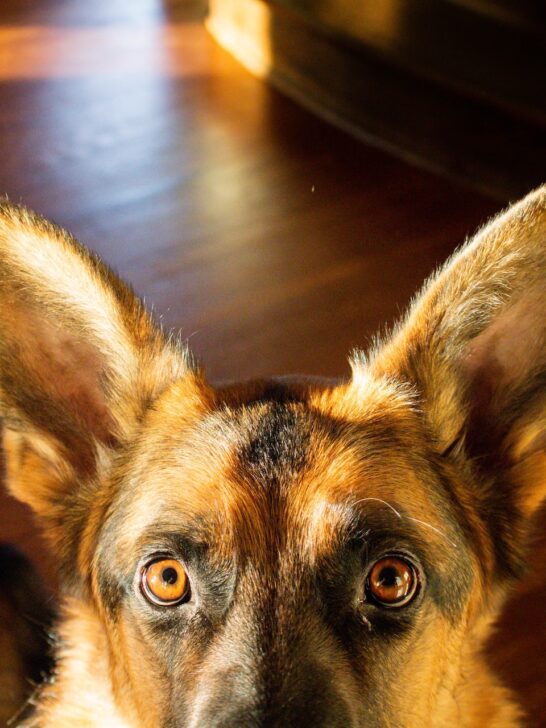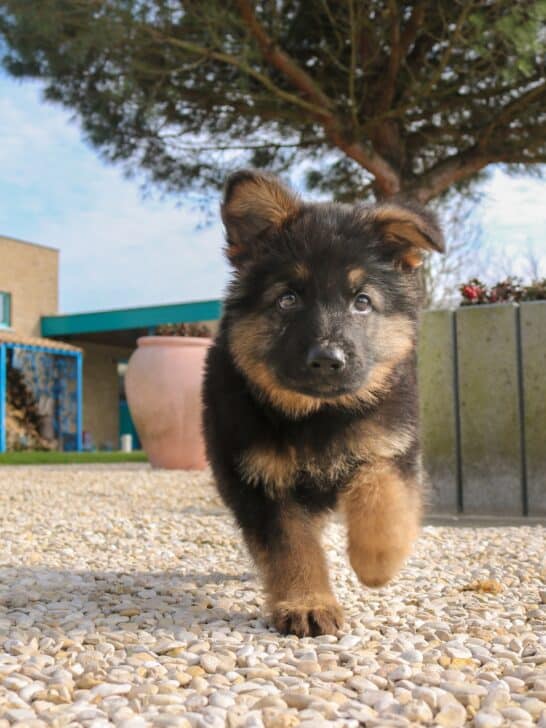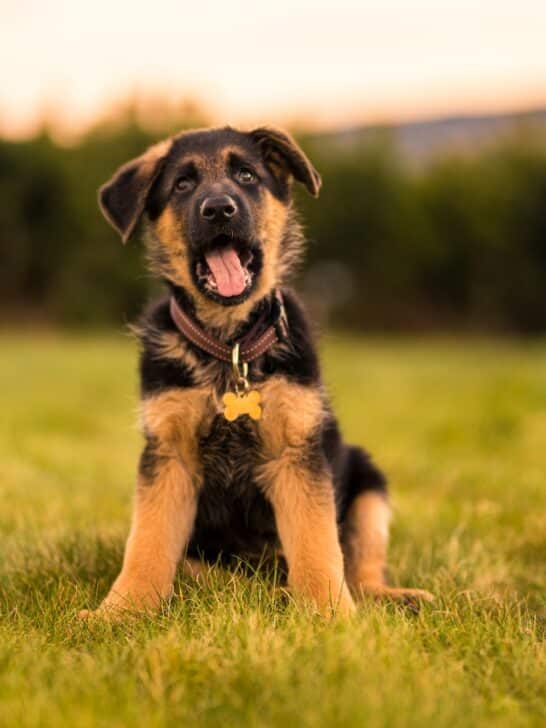German Shepherd Growth Chart: When Do German Shepherds Stop Growing?
There is no doubt the adult German Shepherd dog can grow up to be really big! However, a variety of factors can also influence how large your GSD grows up to be.
But the biggest surprise to many first-time German Shepherd dog owners is how long it can take a German Shepherd puppy to grow up to its full adult size.
This process often stretches out over 36 months or longer!
Of course, the very day your GSD puppy comes home with you, you are already planning, taking into account your dog’s changing needs for food, bedding, activity, veterinary care, crates, and more.
But is there any way you can know for sure when your dog will stop growing? In this article, you will learn step by step exactly what to expect as your GSD grows up.

How Long Does It Take for a German Shepherd Puppy to Grow Up?
As we just mentioned, the German shepherd’s growth process can extend as long as three years (36 months).
As a general rule of thumb, you can expect that the majority of the growing-up process will likely be concluded by around 24 months.
First-time owners can be easily convinced their GSD puppy is done growing at 12 months!
But while the German shepherd’s growth rate and visible change will slow down after 12 months have passed, it won’t stop. The additional growth will be more subtle and more internal – so not so easily seen.
This is important for you to know as a GSD owner!
Just because you can’t see the growth as easily, you still need to remain very mindful of the delicate process inside your dog, which we will talk about in the next section here.
A General Timeline of German Shepherd Puppy Growth
If you watched the YouTube videos, you already saw how quickly a German Shepherd puppy could go from looking like an adorable little teddy bear to a sleek and serious adult canine.
Here is a general timeline you can use for major german shepherd growth benchmarks that may include upgrading your German Shepherd’s crate, kennel, dog bed, collar and leash, food, and toys.
Neonatal Period: Whelping to 10 Days
You likely hadn’t yet met your puppy before they passed quickly through this stage, which ends around 10 days after birth when the puppy first opens their eyes.
Transitional Period: 10 to 20 Days
This is another period that takes place before you and your puppy meet.
During the transitional period, your GSD puppy gets used to the active, visual world going on all around them, including the presence of littermates.
Socialization Period: Three Weeks to Three Months
The socialization phase is incredibly important to help your young German Shepherd puppy get on in the company of others, which includes other dogs, other animals, and, of course, people.
Because so much positive socialization happens while your pup is still with their mom and littermates, it is important not to take your German Shepherd puppy home too soon!
Juvenile Period: Three Months to Six Months
Starting around the age of three months, your German Shepherd puppy heads straight into serious “puppyhood,” with all the rambunctiousness, curiosity, high energy, short attention span, and dis(obedience) puppy owners have come to expect.
Obedience training and training, in general, should be introduced promptly and before your GSD starts to mature sexually at around the age of five months.
Adolescent Period: Six Months to 24 Months
The adolescent period represents perhaps the most visually evident portion of your german shepherd puppy’s growth spurt.
At some point in this period (whenever your dog’s veterinarian advises), you will also switch from puppy food to adult dog food.
Your little dog will become a big dog right before your eyes! The puppy coat will transition to the adult coat.
This is when it is advisable to have your puppy “fixed” (unless you plan to breed your dog) to control hormonal behavior issues.
By the end of 24 months, you will have a mostly or fully adult German Shepherd dog at your side.
Adult Period: 24 Months to Six Years
Depending on your German Shepherd’s gender and genetics, your dog may reach full adult weight, height, and size by 24 months or may continue growing for up to another 12 months.
Regardless, the trials and tribulations of puppyhood will, at last, begin to fade, and you will bask in the brilliant sunlight of the loyal, loving, affectionate dog that is America’s second most popular purebred dog breed, the German Shepherd dog.
Senior Period: Six Years Onward
German Shepherd dogs, like many large and giant breed dogs, have relatively brief life expectancies.

German Shepherd Growth Chart: One Month to One Year
| Age | Height | Weight |
| One month | 4-6″ | Approx. 5.5-9 pounds |
| Two months | 7-9″ | Approx. 16-20 pounds |
| Three months | 9-11″ | Approx. 22-30 pounds |
| Four months | 11-14″ | Approx. 35-40 pounds |
| Five months | 14-16″ | Approx. 40-49 pounds |
| Six months | 16-18″ | Approx. 49-57 pounds |
| Seven months | 19-20″ | Approx. 57-62 pounds |
| Eight months | 20-22″ | Approx. 62-66 pounds |
| Nine months | 21-23″ | Approx. 64-71 pounds |
| Ten months | 22-24″ | Approx. 66-73 pounds |
| Eleven months | 22-24″ | Approx. 71-75 pounds |
| One year | 22-24″ | Approx. 71-79 pounds |
Does Growth Differ Between Male and Female Adult German Shepherd Dogs?
Now it is time to focus more on gender and german shepherd growth rates.
The official breed standard for the German Shepherd dog states that adult dogs can stand between 22 and 26 inches tall (paw pads to shoulders) and weigh anywhere from 50 to 90 pounds.
The official breed standard also specifies that adult male german shepherds often stand taller and weigh more than an adult female german shepherd.
Typically, an adult male German Shepherd will stand two inches taller and weigh anywhere from 15 to 20 pounds more than an adult female german shepherd.
This is exactly why a bigger German Shepherd male dog is likely to continue growing for a longer period because the skeleton can only grow so fast.
Male German Shepherd
This German Shepherd growth chart timeline is courtesy of Von Geliebten Haus GSD breeders. It uses an average German Shepherd pup that weighs 64 pounds at one year of age.
One month old
A one-month-old German Shepherd puppy may weigh up to 9.2 pounds, representing about 11 percent of the growing left to do.
Two months old
A two-month-old GSD puppy may weigh up to 19.9 pounds, representing about 26 percent of the growing left to do.
Three months old
A three-month-old German Shepherd puppy may weigh up to 31.3 pounds, representing about 41 percent of the growing left to do.
Four months old
A four-month-old German Shepherd puppy may weigh up to 41.8 pounds, representing about 55 percent of the growing left to do.
Five months old
A five-month-old German Shepherd puppy may weigh up to 50.6 pounds, representing about 66 percent of the growing left to do.
Six months old
A six-month-old German Shepherd puppy may weigh up to 57.4 pounds, representing about 75 percent of the growing left to do.
Seven months old
A seven-month-old German Shepherd puppy may weigh up to 62.6 pounds, representing about 82 percent of the growing left to do.
Eight months old
An eight-month-old German Shepherd puppy may weigh up to 66.4 pounds, representing about 87 percent of the growing left to do.
Nine months old
A nine-month-old German Shepherd puppy may weigh up to 69.4 pounds, representing about 91 percent of the growing left to do.
Ten months old
A ten-month-old German Shepherd puppy may weigh up to 72 pounds, representing about 94 percent of the growing left to do.
Eleven months old
An eleven-month-old German Shepherd puppy may weigh up to 74.3 pounds, representing about 97 percent of the growing left to do.
Twelve months old
A twelve-month-old German Shepherd puppy may weigh up to 76 pounds, representing about 100 percent of the growing left to do.

Female German Shepherd
For a female German Shepherd puppy, the weight range in adulthood typically varies between 50 pounds and 80 pounds. Puppies will be between 22 to 24 inches tall (paw pads to shoulders) on average.
This growth chart timeline is again courtesy of Von Geliebten Haus GSD breeders. It uses an average female German Shepherd that weighs 64 pounds at one year of age.
One month old
A one-month-old German Shepherd puppy may weigh up to 7 pounds, representing about 11 percent of the growing left to do.
Two months old
A two-month-old German Shepherd puppy may weigh up to 16 pounds, representing about 26 percent of the growing left to do.
Three months old
A three-month-old German Shepherd puppy may weigh up to 27 pounds, representing about 41 percent of the growing left to do.
Four months old
A four-month-old German Shepherd puppy may weigh up to 36 pounds, representing about 55 percent of the growing left to do.
Five months old
A five-month-old German Shepherd puppy may weigh up to 44 pounds, representing about 66 percent of the growing left to do.
Six months old
A six-month-old German Shepherd puppy may weigh up to 50 pounds, representing about 75 percent of the growing left to do.
Seven months old
A seven-month-old German Shepherd puppy may weigh up to 54 pounds, representing about 82 percent of the growing left to do.
Eight months old
An eight-month-old German Shepherd puppy may weigh up to 58 pounds, representing about 87 percent of the growing left to do.
Nine months old
A nine-month-old German Shepherd puppy may weigh up to 60 pounds, representing about 91 percent of the growing left to do.
Ten months old
A ten-month-old German Shepherd puppy may weigh up to 61 pounds, representing about 94 percent of the growing left to do.
Eleven months old
An eleven-month-old German Shepherd puppy may weigh up to 63 pounds, representing about 97 percent of the growing left to do.
Twelve months old
A twelve-month-old German Shepherd puppy may weigh up to 64 pounds, representing about 100 percent of the growing left to do.
Panosteitis: “Growing Pains” in a German Shepherd Dog
The United Federation of Animal Welfare (UFAW) explains that some GSD puppies will develop panosteitis, a painful inflammation of the bone marrow.
Panosteitis is sometimes nicknamed “growing pains” because it occurs during a puppy’s growing up period.
The bone marrow will become inflamed and sore, sometimes to a level where it becomes excruciating to your dog.
In most cases, panosteitis will last anywhere from a few days to a few weeks or even longer and then dissipate. However, it may recur several times while your GSD puppy is still growing.
While panosteitis lasts, your puppy may limp, whine, whimper, and exhibit lameness that seems to move from one leg to another in no apparent pattern.
Panosteitis is thought to have genetic (heritable) origins and is unfortunately quite common in the German Shepherd breed.
However, researchers don’t understand how to limit Panosteitis in German shepherd puppies or even what genes (if any) may contribute to the condition.
Treating panosteitis usually involves giving a German shepherd puppy pain medications. Unfortunately, many pain medications have uncomfortable side effects, including stomach upset, and gastrointestinal distress.

Can You Guess the Adult Size of a German Shepherd Puppy?
As VomGeliebten GSD Breeders explains, there is a myth in the German Shepherd dog lover community that bigger is better in every way.
But the fact is that the German Shepherd dog breed was not created to be a big, bulky dog.
These dogs were created to be livestock herding working dogs. To do this, they need to be light on their feet, athletic, and rangy so they can move and navigate quickly.
So you want to steer clear of any breeder that is advertising “oversized” German Shepherd dogs.
While some GSDs are naturally bigger than others, and males tend to be taller and heavier than females, this is not always the case.
Most importantly, having a smaller German Shepherd who finishes growing quicker than what you see on this growth chart doesn’t mean you did something wrong.
There’s a handy method you can use to ‘guesstimate’ the minimum and maximum height and weight your puppy might reach when they’re completely done growing.
Here is more information regarding German Shepherd puppy development.
Start with the Dog Breed Standard
According to the German Shepherd Dog Club of America, the German Shepherd as a breed typically stands between 22 and 24 inches tall (paw pads to shoulder tops) for female adult dogs and 24 to 26 inches tall for male adult dogs.
No weight range is given for the official dog breed standard.
However, the standard does say the dog typically measures between 8.5 and 10 inches from the dog’s breastbone (front chest) to pelvis (rear before the tail).
So these can give you some good starting measurements.
The American Kennel Club (AKC) gives a 50 to 90 pounds weight range, with about 10 pounds differences between adult females and adult males.
Learn About the Measurements of Your Puppy’s Parents
The next step to take in guesstimating your German Shepherd puppy’s adult height, weight, and size is to learn as much as you can about the mother and father dog.
Find out from your breeder the exact height, weight, and length measurements for each parent dog. You can also ask the breeder about how long it took each parent dog to complete its growth.
Factor In Your Puppy’s Gender and Genes
Once you know the measurements range for both of your puppy’s parents, you can then take a closer look at which parent dog your puppy most favors genetically.
Gender does not always factor into a puppy’s growth potential, especially if the female parent dog is bigger than the stud (male) parent.
The greatest influence will come from learning as much as possible about which parent dog your puppy seems to most favor in looks.
Your breeder will be in the best position to weigh in on this question, both from the point of view of the parent dogs and the lineage as a whole.
You can also ask where your GSD puppy falls on the size spectrum within their particular litter. While a smaller puppy may end up being a bigger adult dog, this is more the exception than the norm.
For example, if you know that your puppy was the middleweight in the litter, you can expect your adult GSD to maintain that position as all the puppies grow up.
What Happens Inside the Body As a Small GSD Puppy Gets Big?
As Canine Weekly explains, inside your GSD puppy’s body, the bones are growing and going all out to develop the healthiest, strongest skeleton to support your dog’s adult body.
The growth process is not unlike what happens as children grow up!
In other words, for your puppy to grow bigger, its bones first have to grow bigger. This requires a partnership between bone and cartilage. This partnership takes place within centers called growth plates.
The growth plates are located at the ends of the long skeletal bones. Inside each growth plate is an area that is responsible for generating new bone tissue.
This is the most important fact to cement into your memory. As long as the growth plates are still producing new bone tissue, they are relatively soft.
This is because the tissue the growth plates are producing is also soft and flexible.
Only once your German Shepherd puppy has finally grown up as much as they will do will these growth plates and their tissues harden fully.
Since you can’t always tell visually when this process has stopped occurring, you need to err on the side of caution.
How to Take Special Care of Your GSD Puppy’s Growth Plates
Your dog’s veterinarian can be a great help during the sensitive months and years of the growth process.
You need to do two important things to protect and support your GSD puppy to reach their full adult height, weight, and size safely and healthily.
1. Provide an appropriate whole and complete large breed puppy diet
Your dog’s veterinarian will be a key partner for you to ensure your growing puppy is taking in the right amount of essential nutrients, vitamins, trace minerals, and calories.
In most cases, you will be guided to feed a puppy food formulated specifically for large breed puppies that will grow up more slowly over a longer period.
However, if you are feeding a raw diet or making your homemade dog food, you will need to work even more closely with your dog’s veterinarian to ensure your puppy gets the right supplements to feed its growing body.
Just as feeding the wrong food can cause your puppy to grow up too fast, so too can feeding the wrong food stunt growth and cause problems and pain throughout your German Shepherd’s life.
2. Guard against over-exertion in play, exercise, and athletics
As the American Kennel Club (AKC) points out, large breed puppies are known to be more vulnerable to exercise-induced injury while they are still growing.
This is because the growth process takes longer, and their skeletal systems support a great deal of weight.
While no official study exists to definitively say when it is safe to let your GSD make use of their considerable natural athletic ability, your veterinarian can help you assess when and how to add in additional activity as your puppy grows up.
Here, you might be wondering how you will deal with so much rambunctious puppy when you have exercise restrictions!
But it is important to remember that mental activity is just as stimulating and tiring to smart dogs like the German Shepherd!
GSDs are intensely people-oriented and eager to please and will readily take to training sessions and obedience school.
German Shepherd puppies can still exercise by trying interspersing walks or short runs with the mental stimulation of training sessions to keep your pup from over-exerting.
What Are the Warning Signs of Over-Exertion for Growing GSD Puppies?
There are some warning signs to watch for to make sure your German Shepherd puppy isn’t over-taxing their still-growing growth plates and bones.
As the Royal Society for the Prevention of Cruelty to Animals (RSCPA) explains, over-exercising a growing puppy can lead to several musculoskeletal problems even as they are still growing and in adulthood.
Here are the warning signs your GSD puppy may be over-exerting themselves:
- Panting heavily for an extended time frame
- Slowing their pace during play or walks
- Dragging behind you on walks
- Stopping suddenly and laying down
- Drooling, vomiting, or both
- Lameness or limping
How Much Exercise is Too Much for a GSD Puppy?
In general, you want to aim for a moderate daily activity that combines training, free play, interactive play with you, and walks of one mile or less.
Longer walks, hikes, or jogs may be too much for your GSD puppy, even if you don’t see any of the warning signs listed above here.
Tug of war, frisbee, tethered bike rides or runs, and any activity that forces your dog to keep up with you should be avoided at all costs.

Does My GSD Puppy Have Panosteitis or Degenerative Myelopathy or Dysplasia?
According to the Orthopedic Foundation For Animals’ Canine Health Information Center (CHIC) database, the German Shepherd dog may develop several additional known heritable health issues in addition to panosteitis (which is not listed in that database).
These issues include the following:
- Hip dysplasia
- Elbow dysplasia
- Degenerative myelopathy
- Cardiac and eye issues
- Autoimmune thyroiditis
Because the German Shepherd breed can inherit several conditions that can affect the joints, bones, and muscles of the body, it can be challenging to know what is causing health symptoms you may see in your GSD puppy.
Is it panosteitis, growing pains?
Or could it be hip or elbow dysplasia, where the ball socket of the elbow or hip joint fails to form properly?
Or could it be degenerative myelopathy, a degenerative and progressive genetic health condition that causes deterioration of the nerves in the spinal column that eventually results in hindquarters paralysis but (it is thought) no pain?
Or could it perhaps simply be that your GSD puppy is over-exercised and is stiff and sore?
Only one individual can determine what is causing any lameness, pain, or other concerning health symptoms you may be observing in your German Shepherd puppy. That person is your dog’s veterinarian.
As you now know, panosteitis is only really treatable by temporarily limiting activity and offering pain medications, which may have side effects.
Hip and elbow dysplasia is treatable by physical therapy (in mild cases) and surgery (in serious cases).
Degenerative myelopathy has no real treatment or cure. However, in some cases, physical therapy may help improve mobility while the option remains.
Caring for Your Growing German Shepherd Puppy
As you now understand, the growth timeline for a German Shepherd puppy is not set in stone and is also the most critically important phase for your dog’s health.
For this reason, don’t ever hesitate to contact your dog’s veterinarian if you have questions as your GSD puppy is growing up.

FAQ
Can getting your German Shepherd neutered or spayed impact puppy growth?
Another vitally important fact that many German Shepherd owners do not realize until it is too late is that the timing of spay or neuter procedures can greatly affect puppy growth.
As the Journal of Veterinary Medicine and Science explains, a dog neutered or spayed too early is then at risk for a whole range of health issues later in life.
This includes continued growth past what the breed standard suggests is normal or healthy for the German Shepherd dog breed.
Why does having your German Shepherd puppy spayed or neutered too early potentially cause your dog to grow larger than is normal for the breed?
The reason is that the spay or neuter surgery turns off important sex hormones that interact with the soft growth plates in the long leg bones.
When those hormones are removed from the dog’s body through spay/neuter surgery, the growth plates will stay soft for longer and keep telling the long leg bones to grow more and more.
This can result in a very tall dog with more bones, joints, and tissues.
What problems can arise when the growth plates in a German Shepherd’s leg bones don’t close on time?
- Joint dysplasia, including shoulder, hip, and elbow dysplasia, occurs when the major ball and socket joints don’t develop properly.
- Cranial cruciate ligament tears can be stretched beyond what the dog’s body is genetically designed to accommodate.
When is the right time to spay or neuter a GSD puppy?
This is a question that is best discussed with your dog’s veterinarian.
However, many German Shepherd breeders recommend waiting until at least the age of one – when the dog has completed most growth and the growth plates in the long leg bones have closed for good.
The key is to wait until those growth plates have closed, which may mean waiting longer than 12 months to do the spay/neuter surgery and having to endure a restless, sexually mature dog for a few months.
What is the average life expectancy of the German Shepherd?
The average life expectancy of a German Shepherd is between nine and thirteen years. Smaller German Shepherd breeds may live slightly longer than their larger breed counterparts.
How do you know if your German Shepherd is going to be big?
The biggest determining factor of the size of your German Shepherd dog will really come down to the genetic background of its parents.
A German Shepherd is not considered fully grown until they are at least 18 months old. However, their growth rate can continue past this point.
Calories increases growth. So, talk to your vet and see how much they recommend feeding your puppy and have them recommend which dog food would be best.
Watch a German Shepherd Puppy Growing Up!
If you are more of a visual learner or are just in a hurry to see how this whole “growing up process” might play out, you will love this short video.
In this video, owners show the time-stamped growth process of their German Shepherd puppy from the age of seven weeks old up to two years old. The transformation is astonishing.
For an even shorter, sweeter look at the German Shepherd puppy growing up process from seven weeks to one year, and then from one year to two years old, this video is chock-full of cuteness as well as useful information!




















